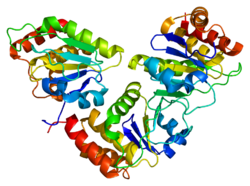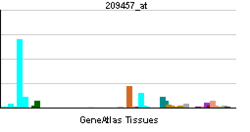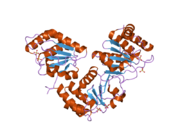- DUSP5
-
Dual specificity phosphatase 5 
PDB rendering based on 2g6z.Available structures PDB 2g6z Identifiers Symbols DUSP5; DUSP; HVH3 External IDs OMIM: 603069 MGI: 2685183 HomoloGene: 3256 GeneCards: DUSP5 Gene Gene Ontology Molecular function • protein tyrosine phosphatase activity
• hydrolase activity
• MAP kinase tyrosine/serine/threonine phosphatase activityCellular component • nucleus
• nucleoplasmBiological process • inactivation of MAPK activity
• endoderm formation
• protein dephosphorylation
• peptidyl-tyrosine dephosphorylationSources: Amigo / QuickGO RNA expression pattern 
More reference expression data Orthologs Species Human Mouse Entrez 1847 240672 Ensembl ENSG00000138166 ENSMUSG00000034765 UniProt Q16690 n/a RefSeq (mRNA) NM_004419 NM_001085390.1 RefSeq (protein) NP_004410 NP_001078859.1 Location (UCSC) Chr 10:
112.26 – 112.27 MbChr 19:
53.6 – 53.62 MbPubMed search [1] [2] Dual specificity protein phosphatase 5 is an enzyme that in humans is encoded by the DUSP5 gene.[1][2]
The protein encoded by this gene is a member of the dual specificity protein phosphatase subfamily. These phosphatases inactivate their target kinases by dephosphorylating both the phosphoserine/threonine and phosphotyrosine residues. They negatively regulate members of the mitogen-activated protein (MAP) kinase superfamily (MAPK/ERK, SAPK/JNK, p38), which are associated with cellular proliferation and differentiation. Different members of the family of dual specificity phosphatases show distinct substrate specificities for various MAP kinases, different tissue distribution and subcellular localization, and different modes of inducibility of their expression by extracellular stimuli. This gene product inactivates ERK1, is expressed in a variety of tissues with the highest levels in pancreas and brain, and is localized in the nucleus.[2]
References
- ^ Martell KJ, Kwak S, Hakes DJ, Dixon JE, Trent JM (Jan 1995). "Chromosomal localization of four human VH1-like protein-tyrosine phosphatases". Genomics 22 (2): 462–4. doi:10.1006/geno.1994.1411. PMID 7806236.
- ^ a b "Entrez Gene: DUSP5 dual specificity phosphatase 5". http://www.ncbi.nlm.nih.gov/sites/entrez?Db=gene&Cmd=ShowDetailView&TermToSearch=1847.
Further reading
- Robertson NG, Khetarpal U, Gutiérrez-Espeleta GA et al. (1995). "Isolation of novel and known genes from a human fetal cochlear cDNA library using subtractive hybridization and differential screening". Genomics 23 (1): 42–50. doi:10.1006/geno.1994.1457. PMID 7829101.
- Kwak SP, Dixon JE (1995). "Multiple dual specificity protein tyrosine phosphatases are expressed and regulated differentially in liver cell lines". J. Biol. Chem. 270 (3): 1156–60. doi:10.1074/jbc.270.3.1156. PMID 7836374.
- Ishibashi T, Bottaro DP, Michieli P et al. (1994). "A novel dual specificity phosphatase induced by serum stimulation and heat shock". J. Biol. Chem. 269 (47): 29897–902. PMID 7961985.
- Strausberg RL, Feingold EA, Grouse LH et al. (2003). "Generation and initial analysis of more than 15,000 full-length human and mouse cDNA sequences". Proc. Natl. Acad. Sci. U.S.A. 99 (26): 16899–903. doi:10.1073/pnas.242603899. PMC 139241. PMID 12477932. http://www.pubmedcentral.nih.gov/articlerender.fcgi?tool=pmcentrez&artid=139241.
- Ueda K, Arakawa H, Nakamura Y (2003). "Dual-specificity phosphatase 5 (DUSP5) as a direct transcriptional target of tumor suppressor p53". Oncogene 22 (36): 5586–91. doi:10.1038/sj.onc.1206845. PMID 12944906.
- Gerhard DS, Wagner L, Feingold EA et al. (2004). "The Status, Quality, and Expansion of the NIH Full-Length cDNA Project: The Mammalian Gene Collection (MGC)". Genome Res. 14 (10B): 2121–7. doi:10.1101/gr.2596504. PMC 528928. PMID 15489334. http://www.pubmedcentral.nih.gov/articlerender.fcgi?tool=pmcentrez&artid=528928.
- Mandl M, Slack DN, Keyse SM (2005). "Specific Inactivation and Nuclear Anchoring of Extracellular Signal-Regulated Kinase 2 by the Inducible Dual-Specificity Protein Phosphatase DUSP5". Mol. Cell. Biol. 25 (5): 1830–45. doi:10.1128/MCB.25.5.1830-1845.2005. PMC 549372. PMID 15713638. http://www.pubmedcentral.nih.gov/articlerender.fcgi?tool=pmcentrez&artid=549372.
- Jeong DG, Cho YH, Yoon TS et al. (2007). "Crystal structure of the catalytic domain of human DUSP5, a dual specificity MAP kinase protein phosphatase". Proteins 66 (1): 253–8. doi:10.1002/prot.21224. PMID 17078075.
- Sarközi R, Miller B, Pollack V et al. (2007). "ERK1/2-driven and MKP-mediated inhibition of EGF-induced ERK5 signaling in human proximal tubular cells". J. Cell. Physiol. 211 (1): 88–100. doi:10.1002/jcp.20909. PMID 17131384.
PDB gallery Esterase: protein tyrosine phosphatases (EC 3.1.3.48) Class I Classical PTPsReceptor type PTPs (PTPRA, PTPRB, PTPRC, PTPRD, PTPRE, PTPRF, PTPRG, PTPRH, PTPRJ, PTPRK, PTPRM, PTPRN, PTPRN2, PTPRO, PTPRQ, PTPRR, PTPRS, PTPRT, PTPRU, PTPRZ)
Non receptor type PTPs (PTPN1, PTPN2, PTPN3, PTPN4, PTPN5, PTPN6, PTPN7, PTPN9, PTPN11, PTPN12, PTPN13, PTPN14, PTPN18, PTPN20, PTPN21, PTPN22, PTPN23MAPK phosphatases (MKPs) (DUSP1, DUSP2, DUSP4, DUSP5, DUSP6, DUSP7, DUSP8, DUSP9, DUSP10, DUSP16, MK-STYX)
CDC14s (CDC14A, CDC14B, CDKN3, PTP9Q22)
Atypical DSPs (DUSP3, DUSP11, DUSP12, DUSP13A, DUSP13B, DUSP14, DUSP15, DUSP18, DUSP19, DUSP21, DUSP22, DUSP23, DUSP24, DUSP25, DUSP26, DUSP27, EMP2A, RNGTT, STYX)
Phosphatase and tensin homologs (PTENs) (PTEN, TPIP, TPTE, TNS, TENC1)
Myotubularins (MTM1, MTMR2, MTMR3, MTMR4, MTMR5, MTMR6, MTMR7, MTMR8, MTMR9, MTMR10, MTMR11, MTMR12, MTMR13, MTMR14, MTMR15)Class II Class III Class IV B enzm: 1.1/2/3/4/5/6/7/8/10/11/13/14/15-18, 2.1/2/3/4/5/6/7/8, 2.7.10, 2.7.11-12, 3.1/2/3/4/5/6/7, 3.1.3.48, 3.4.21/22/23/24, 4.1/2/3/4/5/6, 5.1/2/3/4/99, 6.1-3/4/5-6 Categories:- Human proteins
- Chromosome 10 gene stubs
Wikimedia Foundation. 2010.

